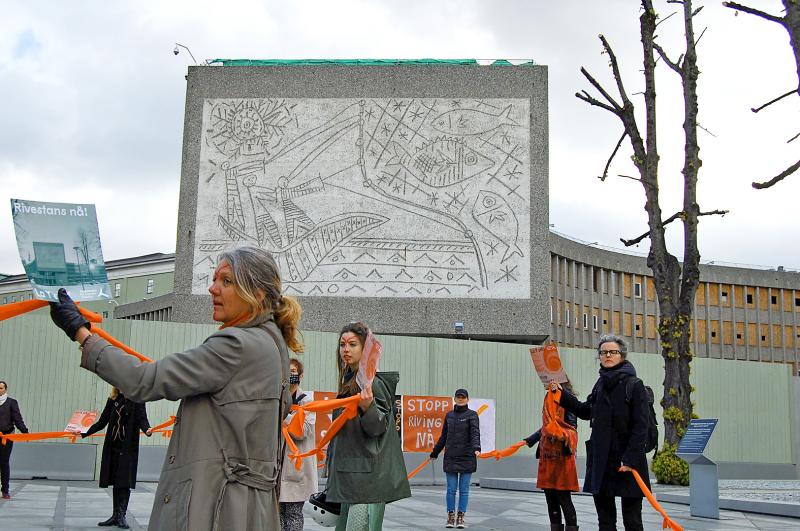Masks were rare and social distances varied, but the human chain spread out, as protestors in Oslo braved the risk of COVID-19 infection in a last-ditch bid to save a building adorned by Spanish master painter Pablo Picasso.
Damaged in right-wing extremist Anders Behring Breivik’s July 2011 attacks, the “Y Block,” a government building complex named for its shape and completed in 1969, is to be demolished soon.
On its grey cement walls are two Picasso drawings, sandblasted by Norwegian artist Carl Nesjar, who collaborated with the Spaniard.

Photo: AFP
On the facade facing the street, The Fishermen depicts three men hauling their oversized catch on board their boat. In the lobby, The Seagull shows the bird, its wings spread wide, devouring a fish.
Etched in the Spanish painter’s childlike strokes, the two works would be cut out and relocated to new government buildings due to be built in the central Oslo neighborhood.
However, not everyone likes that plan.
“We’re going to be kicking ourselves for years,” said Erik Lie, one of the about 200 Norwegians who came to protest the demolition.
“I hope it’s not too late,” he said.“But this will probably be a pile of rubble soon.”
Because of COVID-19, protesters were linked by meter-long ribbons in a bid to keep them at a safe distance from one another.
The Norwegian Directorate of Public Construction and Property, which oversees the demolition, said the murals are to be dismantled before the end of spring.
The nearby “H Block” building, built in the late 1950s and which has three other Picasso murals, was home to the prime minister’s offices until Breivik blew up a van loaded with 950kg of explosives at its base.
“H Block” would be renovated and continue to tower over the new ministry buildings.
“‘Y Block’ is an iconic building in Oslo that has survived a terrorist attack, and now the government wants to tear it down, and nobody can actually give a good argument for why they should,” said Tone Dalen, one of the protests’ figureheads.
The government said that the demolition to make space for new buildings was a difficult, but necessary decision.
“It will improve security and accessibility for cyclists and pedestrians, and will provide a more open and greener space, as well as offices suited to the future ministries,” Minister of Local Government Nikolai Astrup said.
“A lot of people think that it’s Picasso that deserves to be preserved, but it’s also the architecture and the interaction between ‘Y Block’ and ‘H Block,’ the history that it represents,” Lie said.
“These are monuments that illustrate the rebuilding of Norway after the war, and everything that I associate with the development of modern society,” he added.

The death of a former head of China’s one-child policy has been met not by tributes, but by castigation of the abandoned policy on social media this week. State media praised Peng Peiyun (彭珮雲), former head of China’s National Family Planning Commission from 1988 to 1998, as “an outstanding leader” in her work related to women and children. The reaction on Chinese social media to Peng’s death in Beijing on Sunday, just shy of her 96th birthday, was less positive. “Those children who were lost, naked, are waiting for you over there” in the afterlife, one person posted on China’s Sina Weibo platform. China’s

‘NO COUNTRY BUMPKIN’: The judge rejected arguments that former prime minister Najib Razak was an unwitting victim, saying Najib took steps to protect his position Imprisoned former Malaysian prime minister Najib Razak was yesterday convicted, following a corruption trial tied to multibillion-dollar looting of the 1Malaysia Development Berhad (1MDB) state investment fund. The nation’s high court found Najib, 72, guilty on four counts of abuse of power and 21 charges of money laundering related to more than US$700 million channeled into his personal bank accounts from the 1MDB fund. Najib denied any wrongdoing, and maintained the funds were a political donation from Saudi Arabia and that he had been misled by rogue financiers led by businessman Low Taek Jho. Low, thought to be the scandal’s mastermind, remains

‘POLITICAL LOYALTY’: The move breaks with decades of precedent among US administrations, which have tended to leave career ambassadors in their posts US President Donald Trump’s administration has ordered dozens of US ambassadors to step down, people familiar with the matter said, a precedent-breaking recall that would leave embassies abroad without US Senate-confirmed leadership. The envoys, career diplomats who were almost all named to their jobs under former US president Joe Biden, were told over the phone in the past few days they needed to depart in the next few weeks, the people said. They would not be fired, but finding new roles would be a challenge given that many are far along in their careers and opportunities for senior diplomats can

Australian Prime Minister Anthony Albanese yesterday announced plans for a national bravery award to recognize civilians and first responders who confronted “the worst of evil” during an anti-Semitic terror attack that left 15 dead and has cast a heavy shadow over the nation’s holiday season. Albanese said he plans to establish a special honors system for those who placed themselves in harm’s way to help during the attack on a beachside Hanukkah celebration, like Ahmed al-Ahmed, a Syrian-Australian Muslim who disarmed one of the assailants before being wounded himself. Sajid Akram, who was killed by police during the Dec. 14 attack, and